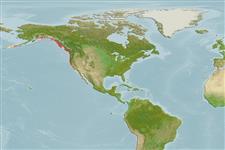Common names from other countries
Environment: milieu / climate zone / depth range / distribution range
Ecologie
marien demersaal; diepte 20 - 80 m (Ref. 51666). Temperate
Eastern Pacific: Aleutian Islands, Alaska to San Miguel Island, southern California, USA.
Grootte / Gewicht / Leeftijd
Maturity: Lm ? range ? - ? cm
Max length : 15.0 cm TL mannelijk / geslacht onbekend; (Ref. 2850)
Korte beschrijving
Determinatiesleutels | Morfologie | Morfometrie
Dorsale stekels (totaal) : 53 - 55; Dorsale zachte stralen (totaal) : 0; Anale stekels: 1; Anale zachte stralen: 37 - 42. Caudal rounded (Ref. 6885). Color variable- males brownish, sometimes with a red tinge; pale spots rimmed with darker on sides of body; spots fainter, smaller, and more numerous dorsally on sides; light on lower part of head with several brown streaks; white on pelvic fins and anterior part of anal fin; other fins with brown pigment spots in bands forming faint bars. Females nearly plain brown on body; in line spread along middle of dorsal fin about 13 dark spots each surrounded by a clear area to form prominent ocelli (Ref. 6885).
Usually in intertidal and subtidal rocky areas (Ref. 2850, 51666). Sometimes hides in crevices and tubeworms holes with only head protruding (Ref. 2850).
Levenscyclus en paargedrag
Maturities | Voortplanting | Spawnings | Egg(s) | Fecundities | Larven
Eschmeyer, W.N., E.S. Herald and H. Hammann, 1983. A field guide to Pacific coast fishes of North America. Boston (MA, USA): Houghton Mifflin Company. xii+336 p. (Ref. 2850)
Status op de Rode Lijst van het IUCN (Ref. 130435)
CITES (Ref. 128078)
Not Evaluated
Gevaar voor de mens
Harmless
Gebruik door de mens
Visserij: commercieel; Aquarium: Commercieel
Tools
Speciale rapporten
Download XML
Internetbronnen
Estimates based on models
Preferred temperature (Ref.
115969): 4.9 - 11.6, mean 7.9 (based on 39 cells).
Fylogenetische diversiteitsindex (Ref.
82804): PD
50 = 0.5039 [Uniqueness, from 0.5 = low to 2.0 = high].
Bayesian length-weight: a=0.00372 (0.00147 - 0.00941), b=3.17 (2.95 - 3.39), in cm Total Length, based on LWR estimates for this (Sub)family-body shape (Ref.
93245).
Trofisch niveau (Ref.
69278): 3.6 ±0.50 se; based on food items.
Weerstandsvermogen (Ref.
120179): Gemiddeld, minimale populatieverdubbelingstijd 1,4-4,4 jaar (Preliminary K or Fecundity.).
Fishing Vulnerability (Ref.
59153): Low vulnerability (10 of 100).
